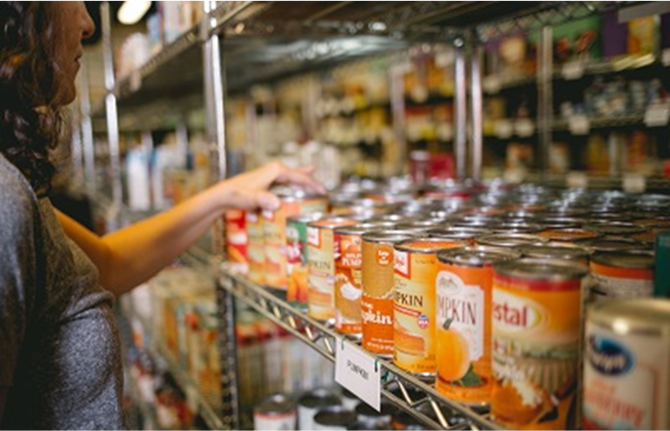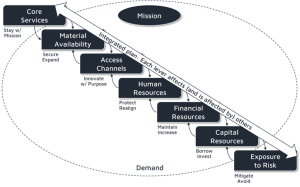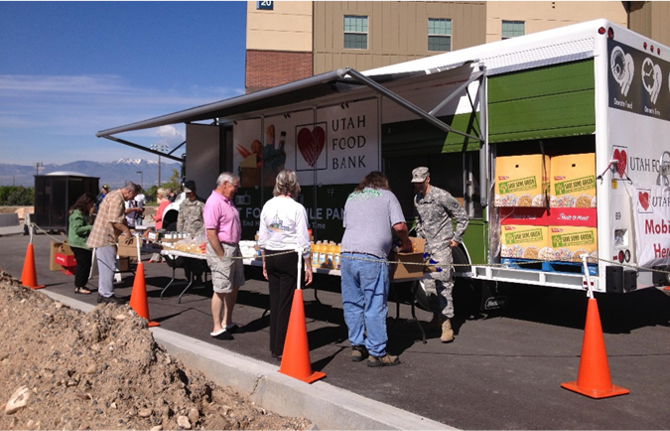3
The effects of Covid-19 have changed non-profit clients’ demand for services. Because so many businesses are struggling and people have lost jobs, the need for certain material assistance food, housing, financial), for example, has greatly increased. At the same time, less “essential” programs may be of relatively lower priority.
Simultaneously, what non-profits can provide—and how—is also impacted. For example, availability of products such as food and supplies may be limited. Organizations that operate in “high-touch” environments may not be able to so, at least for the time being. Financial and human resources (staff and volunteers) may also be constrained.
Certainly, some non-profits could be reactive to changes in client needs, emphasizing key programs while de-emphasizing those that have comparatively less demand (for others, this is much harder). With all of the factors involved, and so many implications, this is not the best approach. The challenges are best handled strategically.

Do uncertainties of Covid-19 prevent strategic thinking? It’s true there are many unknowns, but it is possible to anticipate, plan, monitor, and adapt—four key elements of strategy. The challenge is to find the balance of “supply” and “demand,” with “big picture” logic, immediacy, and a long-term outlook as well.
Figure 2—Supply and Demand Factors[1]
| Supply | Demand |
|
What you can provide
|
What your clients want
|
Figure 2, above, lists key supply and demand factors non-that affect strategic decision-making, along with the reference to the level of risk a non-profit is willing to take in serving its clients. Understanding these factors is essential to crafting responses ahead of time rather than “on the fly,” which can lead to suboptimal choices.
Figure 3 – Interacting Components of Supply

The goal for non-profits is to make informed decisions on how best to meet client demand by recognizing and influencing supply. As can be seen in Figure 3, above, there are many moving, interacting parts. Every choice affects other supply factors, and they have to be connected to accurate demand forecasts. “Big picture” logic is crucial.

While the need to adapt from the “current state” to Covid-19 conditions is basically immediate, decisions have longer-term implications. Non-profits will benefit from a future orientation, given that the pandemic will last for an indeterminate period of time, and things that are done now may be beneficial post-crisis (see Section 7).
The following example (Figure 4) illustrates the challenges. During Covid-19, client demand for food pantry services increases, as does the need for financial assistance due to un- or under-employment. At the same time, clients are less willing—or even unable—to physically appear at the pantry. They need alternative ways to access support.
Figure 4—Example of Interconnected Response Factors at a Food Pantry
| Factor | Current Status | Key Concerns |
| Core Services |
|
|
| Material Availability |
|
|
| Access Channels |
|
|
| Human Resources |
|
|
| Financial Resources |
|
|
| Capital Resources |
|
|
| Exposure to Risk |
|
|
There are some key things to remember when considering the concerns in above example and their interconnections, which directly affect options and decisions:
- Core Services should generally be consistent with the organization’s mission and areas of specialty. Changing to things incompatible with the food pantry’s purpose and skills represent a fundamental shift, and may be difficult both to provide with current resources and to transition back from.
- Material Availability depends to a large extent on relationships. If existing partnerships can be further leveraged and/or new ones formed, they will allow the pantry to accommodate greater demand both today and in the future. If not, the organization will have to choose who to serve, and to what extent.
- Access Channels present both short- and long-term opportunities, but also challenges and risks. It may be beneficial to clients to add, for example, mobile access points or delivery services to accommodate demand.[2] However, the pantry must find the capital resources, and may have to take on more liability.
- Human Resources may be limiting. If, for example, volunteers are unable to work in the pantry’s “high touch” environment, or if employees have to be furloughed due to lack of funds, there are impacts on both how much can be done, and how. Again, it is critical to understand factor interactions.[3]

- Financial Resources are also potentially limiting, as non-profits face static or declining donations, and difficulties holding fundraising events on which they depend. If it cannot find grants and engage donors (see Section 6), the pantry may not be able to keep its workforce, or invest in needed capital assets.
- Capital Resources are important to support new access points. They need to be paid for, shared with other non-profits, “borrowed” from volunteers, or acquired in some other way. Decisions need to be based on availability, funding, and risk tolerance, as well as future strategy regarding delivery.
- Exposure to Risk is a key consideration. Potential liability if an employee contracts the Coronavirus, gets into an accident while delivering food, etc. can be significant. Risk tolerance is key in determining Covid-19 responses, given likelihood and impacts of risks manifesting, and the ability to manage them.
The most effective non-profit responses to the Covid-19 crisis will find balance. Non-profits that make strategic decisions about the kinds and levels of demand they will accommodate based on careful considerations of the above factors, and with both a short- and long-term view, will be most successful—today and in the future.
Go to Session 1 presentation and recordings for a more detailed discussion
- While not specifically supply, “risk tolerance” is also a consideration. ↵
- Expanding delivery options may also have future implications, as the pantry may be able to continue them post-crisis, increasing its value to existing clients and, potentially, its ability to help more people). ↵
- There are also long-term implications such as furloughed employees finding other jobs, which are discussed in more detail in Section 5. ↵
